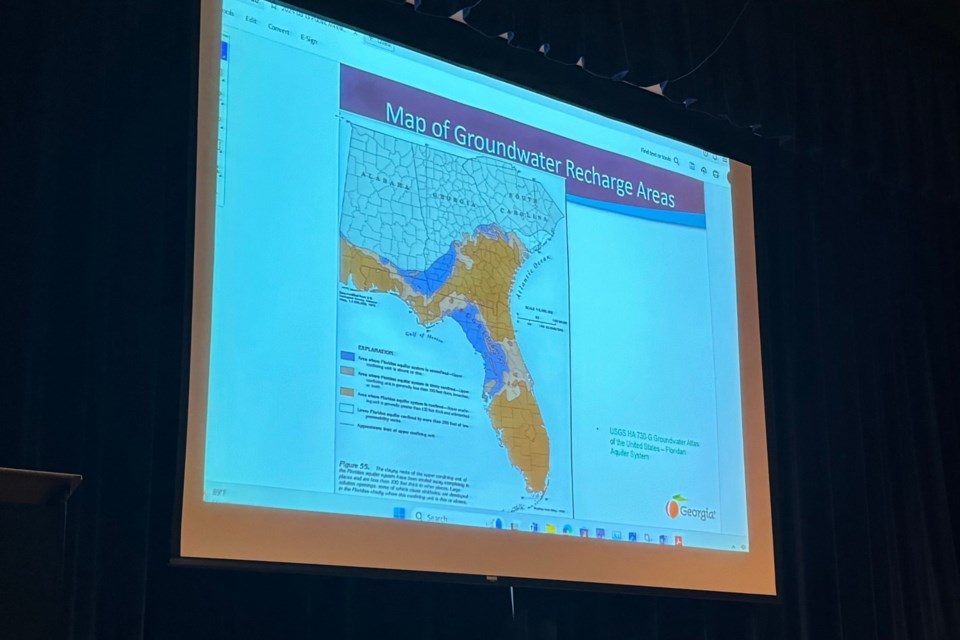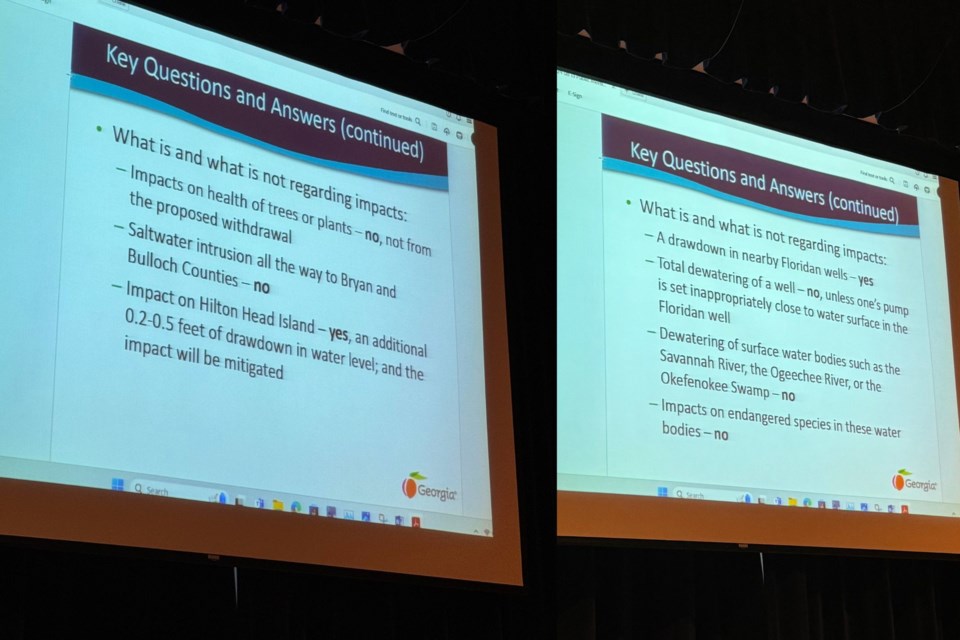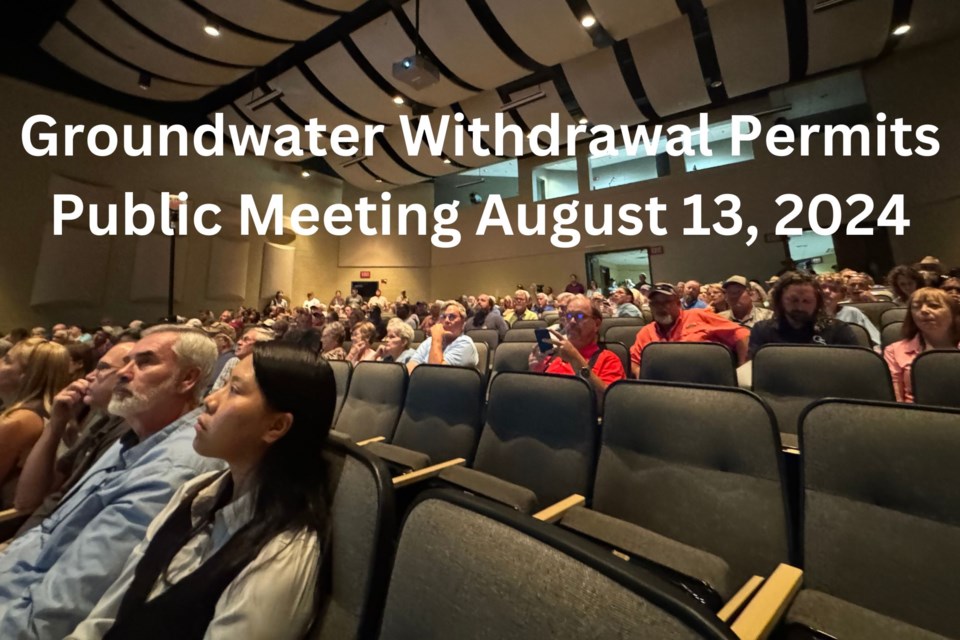A large crowd of concerned citizens attended a public meeting and public hearing on the draft Bryan/Bulloch County Groundwater Withdrawal Permits which was held at the Southeast Bulloch High School by Georgia EPD, on Tuesday, August 13, 2024
Bulloch County has applied for two Floridan aquifer wells in its jurisdiction, seeking approval for withdrawing up to 3.125 million gallons per day (mgd) on an annual average. Similarly, Bryan County has submitted applications for two Floridan aquifer wells located in Bulloch County, requesting permission to withdraw up to 3.500 mgd annually. The combined total of 6.625 mgd will be utilized to supply water to the Bryan County Mega-Site and its associated developments.
EPD has reviewed and drafted permits with consideration of special conditions previously discussed.
Following a public informational meeting held on February 26, 2024, where technical assessments and draft special conditions were discussed, EPD has incorporated feedback and prepared responses to comments received. The agency has updated the permits to address concerns raised by stakeholders, including potential impacts on existing wells, saltwater intrusion, and environmental considerations.
EPD has clarified that a mitigation fund must be established for the duration of groundwater withdrawals, and only licensed water well drillers or pump installers from Georgia are authorized to investigate alleged impacts to existing wells. The permits also stipulate that withdrawals must be replaced with surface water or an alternative source by a designated deadline.
‘The Basic Facts’
-Geological Background Information
The Floridan Aquifer sits below the entire state of florida and large parts of Alabama, South Carolina and Georgia, to include the areas of Bulloch and Bryan County, as well as Savannah and Hilton Head Island.
Numerous members of the public have raised concerns about the depletion of water supply in the aquifer, and the potential for salt water encroachment into the fresh water, as has been seen near HHI.
The experts from the GAEPD presented a slide show of ‘basic facts’ regarding these concerns.
-Floridan Aquifer
The Floridan Aquifer is replenished through the “unconfined” layers. The experts described these areas as points where the aquifer is at surface level and there is no confining layer of soil and rocks separating the surface water from the aquifer.
 These areas are defined in blue on the map below, where essentially, one would be ‘walking on the aquifer’.
These areas are defined in blue on the map below, where essentially, one would be ‘walking on the aquifer’.
Bulloch and Bryan County are above the ‘confined’ layers, where rain/surface water does not get into the aquifer. There is not a close hydraulic connection between surface water and the aquifer in Bulloch County.
Saltwater encroachment has occurred historically in areas where the confinement layer is thin, such as in the Hilton Head Island area. As discussed in a similar meeting held in February, the cone of depression slopes downward into the Savannah area, also negating the likelyhood of saltwater encroachment.
-Proposed groundwater withdrawal
The confining layer below Bulloch County is about 280 feet thick and does not allow water to pass through.
Without the proposed wells, by tapping the upper aquifer at about 285-320 feet below ground level, the pressure from the confining layer would push water up through the wells typically 65 feet below ground level. With the addition of the four wells there would be 19 foot draw down from this level, a minimal impact as reported by the EPD.
Since the 1980s the aquifer has rebounded by 40 feet due to recovery efforts of permitted facilities. Water levels are currently higher than in the 1960s as recorded by the USGS. Voluntary and mandatory reductions have recovered the aquifer, and the EPD says another round of permit reductions is proposed to take place in early 2025
-Key questions and answers
The army corp of engineers permits the development of the Hyundai Plant, not the EPD. The mitigation funding will be established within the permit outline under ‘special conditions’
Pete Peterson, a water well driller, was asked by EPD to give his perspective on the prospective wells.
“Your deep wells are not going to go dry,” stated Peterson, “None of the drillers here have had saltwater in Bryan or Bulloch County.”
Peterson says that for anyone concerned about their well going dry, there are multiple scenarios that would determine the cost of lowering their pump or digging a new well.
- How old is your well?
- Is the well accessible?
- Is there growth over it?
- Is it deep or shallow?
He says that pumping out of shallow wells will not be affected by aquifers. He reports that the last time most pumps were lowered was in 2008 during the drought, when they were dropped 20 feet and have not needed further lowering since.
Peterson implores the Hyundai group to pay for well drillers to assess wells in the area as a preemptive measure to ensure that well waters are not at risk.
Watch the three hours presentation and public hearing below and listen to comments from 16 citizens who signed up to speak.
Live stream




